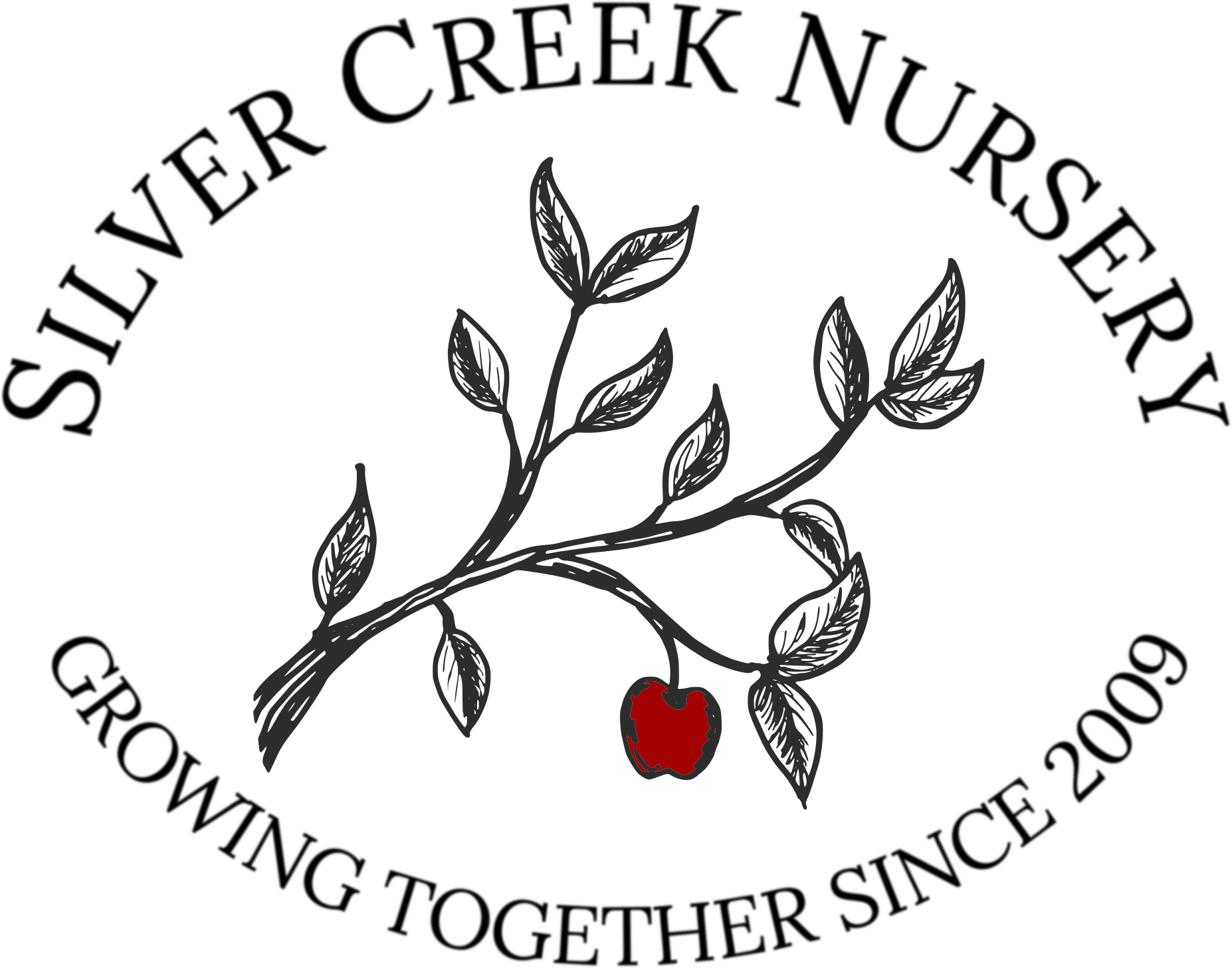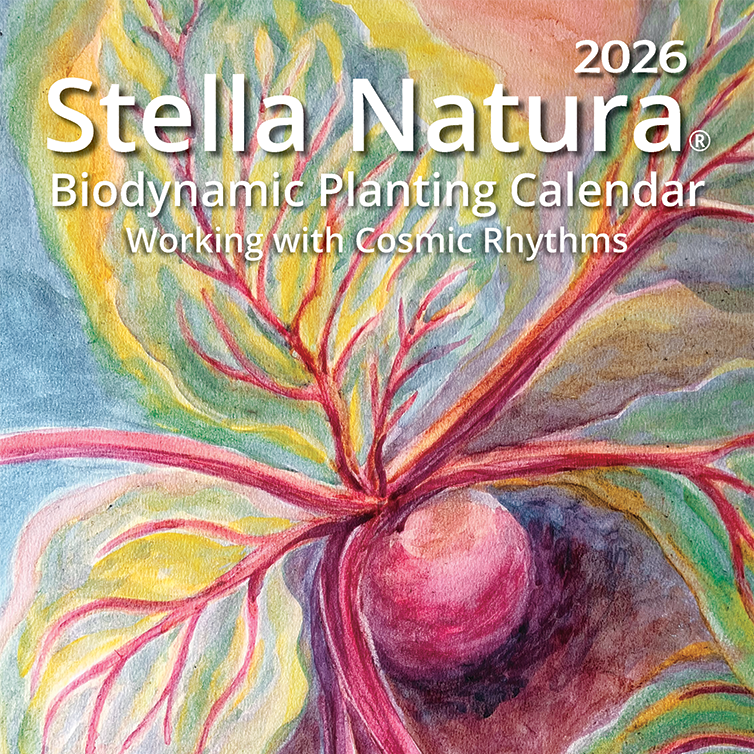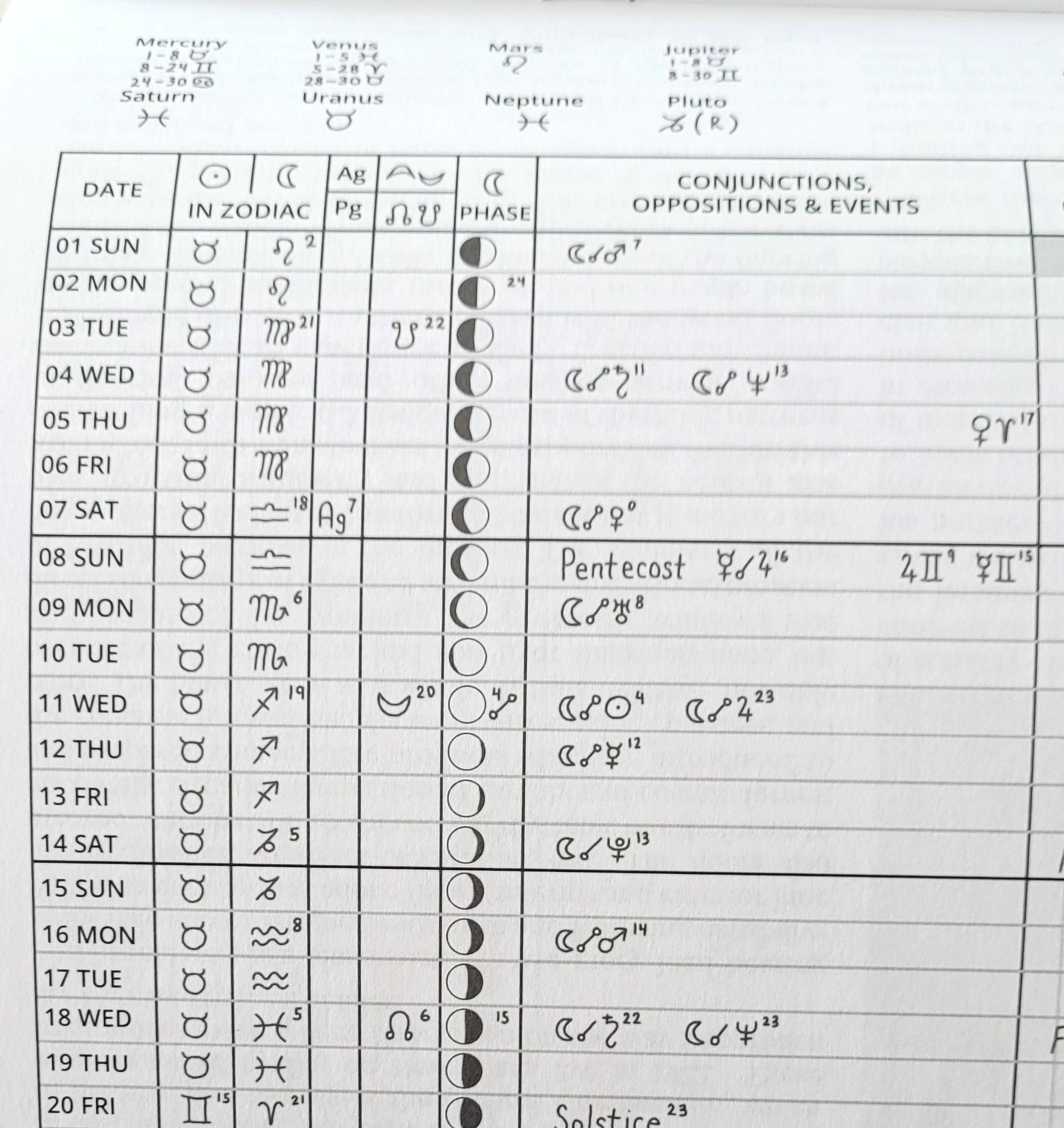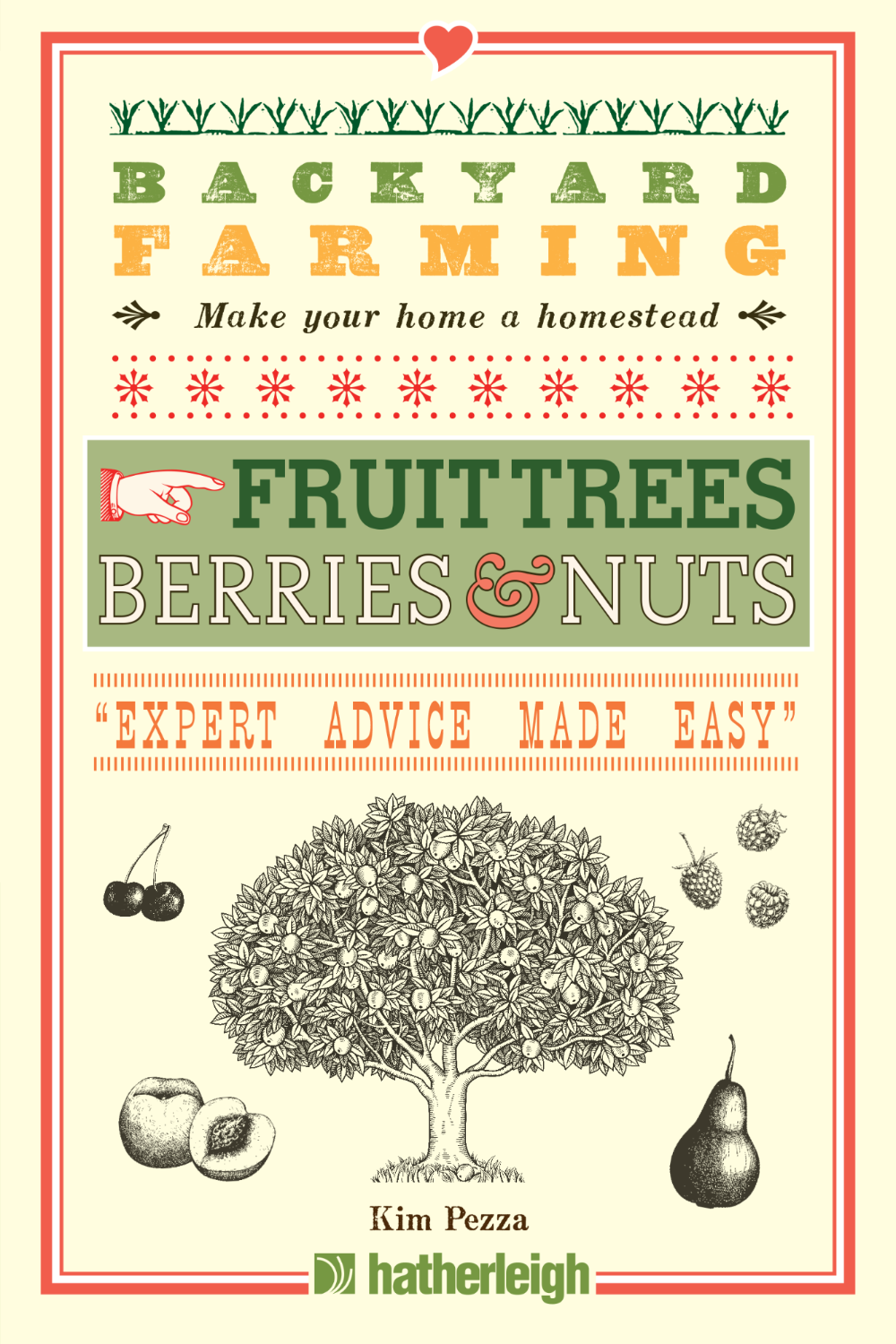Books
Sort by:
40 products
40 products
Stella Natura Biodynamic Planting Calendar for 2026. Working with Cosmic Rhythms.
This beautiful calendar offers advice for when to sow seeds, cultivate your garden and/or farm crop to best enhance their roots, flowers, leaves or fruits. This is based on the Moon’s passage through the constellations of the zodiac. Unfavorable times for sowing are also indicated, to help avoid those inexplicable crop failures.
In addition to planting and astronomical information, the monthly charts continue to be hand-written and accompanied by the thoughtful, inspiring, and informative articles for which Stella Natura has become well-known and appreciated. Also new this year ~ each calendar now includes a link to a free introductory webinar on its principles and practical application!
Initiated by Sherry Wildfeuer in 1978 and heartfully produced by her since that time, Stella Natura has long been a meaningful part of the biodynamic movement. With insightful and engaging articles about agriculture, cosmic influences, and anthroposophy, as well as meticulously hand-drawn charts that detail dates and times for planting/tending/harvesting various crops based on planetary and cosmic influences, it is a faithful companion to gardeners, farmers, and those seeking a glimpse into the practical application of anthroposophical insight to the natural world.
Sherry and Spikenard’s Director, Alex Tuchman, have worked mindfully and joyously together on this transition and have collaborated closely on the last several calendars.
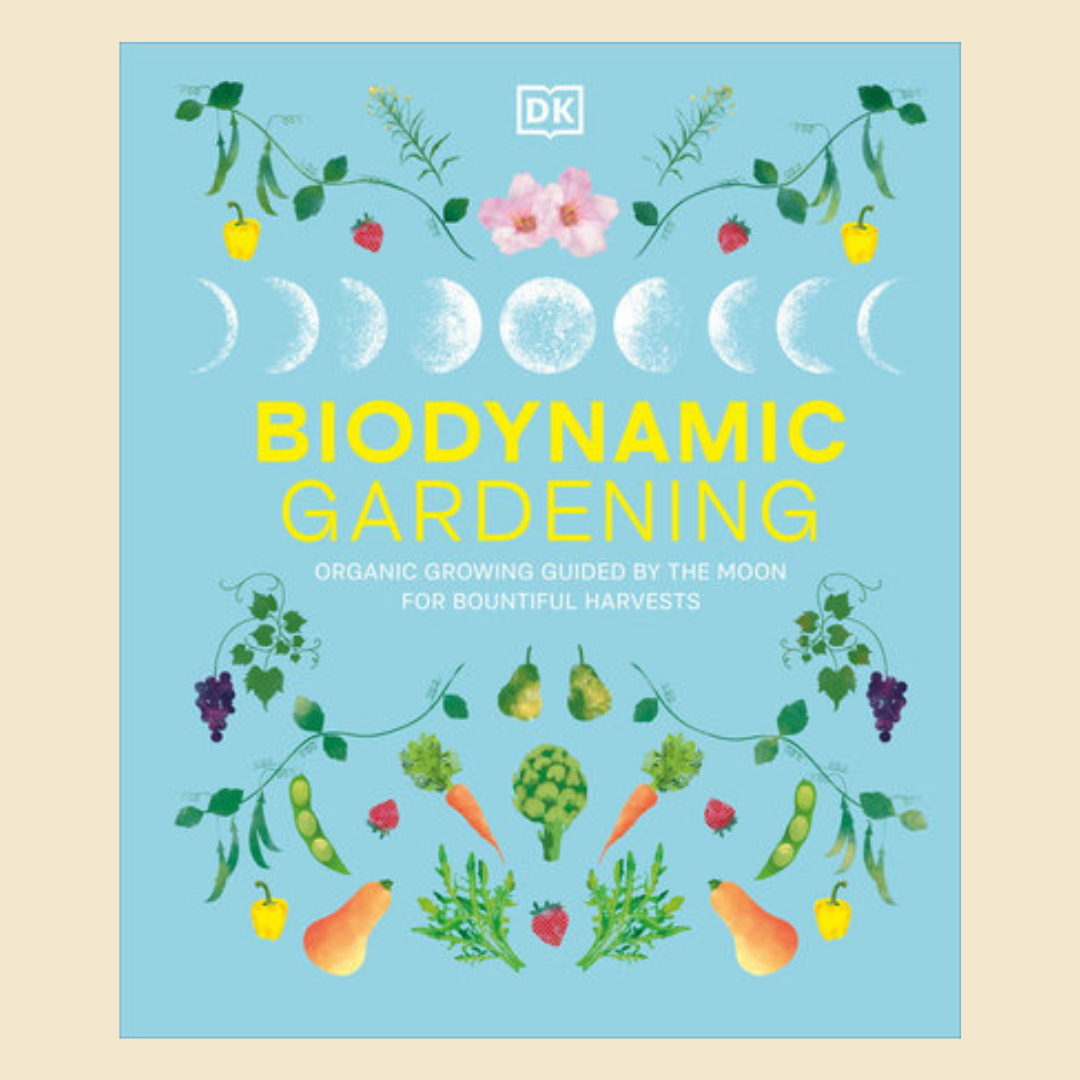
Biodynamic Gardening: Organic Growing Guided By The Moon For Bountiful Harvests
$37.00
Unit price perBiodynamic Gardening: Organic Growing Guided By The Moon For Bountiful Harvests
$37.00
Unit price perReap the benefits of a biodynamic, organic approach to gardening and grow abundant crops in tune with lunar cycles.
Biodynamic Gardening has all you need to know about gardening by the moon:
- A biodynamic calendar enables you to plan the growing year
- Recipes for making natural amendments that improve the health and vitality of soil and plants
- Essential plant profiles of vegetables and flowers provide growing instruction from seed to harvest
Gardening basics such as preparing beds, composting, and watering make Biodynamic Gardening suitable for beginners, as well as experienced gardeners looking for permaculture plus advice to fully synchronize with Nature’s rhythms for optimal crops.
In Cider Planet, Claude Jolicoeur—a longtime, passionate cider maker and author of the international bestseller New Cider Maker’s Handbook—takes readers with him to the world’s greatest cider regions, providing an expertly guided tour laced with his deep understanding and appreciation for how this “Prince of Beverages” is made.
Inside Cider Planet you’ll find:
- Descriptions of global orchard practices
- Specific apple varieties used in different countries and regions
- Detailed histories of the world’s oldest ciderlands
- Profiles of different cider styles and rituals
- Tips and tricks from some of the most knowledgeable cider producers
Cider, long perceived as a European country drink, is now truly a worldwide culinary delight. Jolicoeur talks about new and emergent regions that have contributed to this growing appreciation, and how they are building upon the old traditions while creating their own new ones.
Cold-Hardy Fruits and Nuts is a one-stop compendium of the most productive, edible fruit-and nut-bearing crops that push the boundaries of what can survive winters in cold-temperate growing regions. While most nurseries and guidebooks feature plants that are riddled with pest problems, veteran growers and founders of the Hortus Arboretum and Botanical Gardens, Allyson Levy and Scott Serrano, focus on both common and unfamiliar fruits that have few, if any, pest or disease problems and an overall higher level of resilience.
Inside Cold-Hardy Fruits and Nuts you’ll find:
- Taste profiles for all fifty hardy fruits and nuts, with notes on harvesting and uses
- Plant descriptions and natural histories
- Recommended cultivars, both new and classic
- Propagation methods for increasing plants
- Nut profiles including almonds, chestnuts, walnuts, and pecans
- Fertilization needs and soil/site requirements
- And much more!
Coppice Agroforestry is a richly illustrated, comprehensive guide to resprout silviculture – managing trees and shrubs by coppicing, pollarding, shredding, and pleaching – for a continuous supply of small diameter polewood for products from firewood to fine furniture. Contextualizing resprout silviculture historically, ecologically, and economically, Coppice Agroforestry is a decade in the making, encyclopedic in scope, and written by the hand of a woodsman. Coppice Agroforestry is a deep dive into this ancient practice, blending it with modern science, systems thinking, and tools to land it firmly in the 21st century.
The first in-depth guide for farmers and gardeners who have access to an established woodland and are looking for productive, innovative ways to create a natural forest ecosystems that produces a wide range of food, medicinals, and other non-timber products.
Farming the Woods covers in detail:
- How to cultivate, harvest, and market high-value non-timber forest crops
- Comprehensive information on historical perspectives of forest farming
- How to mimic the forest in a changing climate
- Cultivation of medicinal crops
- How to create a forest nursery
- Harvesting and utilizing wood products
- The role of animals in the forest farm
- How to design and manage your forest farm once it’s set up
Co-authored by Silver Creek Nursery's own Steph! This book was written for all the wonderful folks who have asked us so many grafting questions over the years! Our online grafting course delves into even more detail, but this book is the ultimate guide to get you started!
This book offers a results-oriented approach to mastering grafting techniques. Whether you’re adding a new branch to an existing tree, crafting a whole new tree from a rootstock, or propagating a beloved heirloom tree, this book is your road map to success.
Susan Poizner, author of Fruit Tree Grafting for Everyone and creator of the online grafting and fruit tree care courses at OrchardPeople.com, is joined by Steph Muma of Silver Creek Nursery to help you transform your garden through fruit tree grafting. In this guide, you will learn:
- How to harvest scionwood in the winter.
- Techniques for cleft, bark, and whip grafting in the spring
- Methods for chip and T-bud grafting in the summer
- Essential aftercare practices for long-term graft success
Whether you’re a beginner or an experienced grower, Fruit Tree Grafting for Everyone will empower you to create productive, diverse, and fruit-filled landscapes in your own backyard and beyond.
If you want this item(s) shipped to you and the shipping fees don't seem right, please contact us directly and we'll get a proper rate for you!
When you prune your fruit tree, you’re not just cutting branches; you’re partnering with a living organism to help it thrive. Together, you and your tree work toward a shared goal: a healthy harvest of delicious fruit.
In this book, Susan Poizner, ISA Certified Arborist and award-winning creator of OrchardPeople.com, combines science-based insights with practical strategies to make pruning intuitive. By understanding your tree’s needs, you’ll learn how to work with its natural growth patterns for healthier, more productive results.
With Susan’s guidance, you’ll discover:
- How proper pruning improves your tree’s health and directs its energy into producing higher-quality fruit
- Why winter pruning encourages rapid growth, while summer pruning slows it down
- Step-by-step techniques for Central Leader and Open Center pruning
- How to make your first pruning cut—often on the same day you plant your tree!
- How to train fruit tree branches with weights or clothespins to make them stronger and more productive
Susan Poizner has over a decade of experience helping growers master the art of fruit tree care. In this book, she shares everything you need to know about pruning, with clear, step-by-step instructions to guide you through the process.
If you crave crisp apples, juicy peaches, or varieties of fruit that can never be found in the store, there's no better way than to grow them yourself. Whether you have one tree or a hundred, Orin gives you all the tools you need, from tree selection and planting practices to seasonal feeding guidelines and in-depth pruning tutorials. Along the way, you'll gain a deeper understanding of the core principles of organic gardening and soil stewardship: compost, cultivation, cover crops, and increasing biodiversity for a healthier garden. This book is more than just a gardening manual; it's designed to help you understand the why behind the how, allowing you to apply these techniques to your own slice of paradise and make the best choices for your individual trees.
Filled with informative illustrations, full-color photography, and evocative intaglio etchings by artist Stephanie Martin, Fruit Trees for Every Garden is a striking and practical guide that will enable you to enjoy the great pleasure and beauty of raising homegrown, organic fruit for years to come.
Are you thinking of growing fruit trees? Are you in a hurry to enjoy a delicious organic harvest? Fruit trees don’t grow overnight, but the choices you make and the care you give them can speed up the process. You don’t need a degree in horticulture, and you don’t need to use toxic sprays. Growing fruit trees successfully is simply a matter of knowing what to do and when to do it—and if you know what to look for, your trees will tell you exactly what they need.
This book is for you if you:
- Want to grow fruit trees (like apple, peach, pear, cherry, apricot and plum)
- Are looking for easy techniques that will give you abundant harvests
- Don’t have a lot of time to devote to fruit tree care
- Have never planted a thing
- Are an experienced gardener
- Want to avoid the frustration of trial-and-error learning
If your goal is to grow fruit trees fast, take an hour to read this book. Follow the simple steps inside and you’ll be enjoying a healthy harvest in record time.
Growing Figs in Cold Climates is a complete, full-color, illustrated guide to organic methods for growing delicious figs in cold climates, well outside the traditional hot, arid home of this ancient fruiting tree. Coverage includes:
- Five methods for growing figs in cold climates including overwintering
- Cultivar selection for cool and cold climates
- Pruning techniques for a variety of methods of growing figs in cold climates
- Pest problems and solutions
- Harvesting, including ways to speed ripening, identify ripe fruit, and manage an overabundance
- Small-scale commercial fig production in cold climates.
Fresh figs are juicy, full-bodied, and filled with a honey-sweet flavor, and because truly ripe figs are highly perishable, they are only available to those who grow their own.
By choosing the right cultivars and techniques, figs can be grown across cool and cold growing zones of North America, Europe, and beyond, putting them within reach of almost every gardener. Easy and delicious — if you can grow a houseplant, you can grow a fig.
Fruit trees are delicate and need specialized care, especially when they’re planted in an urban environment, which comes with its own unique challenges. Whether you want to plant a single fruit tree or an entire orchard, this book will show you how to save time and money and be successful right from the start.
Susan Poizner lives in Toronto, and is an excellent resource to anyone seeking to plant fruit trees in their back-yard. We find her book easy to read with clear, concise information and excellent pictures and diagrams.
Life Design for Resilient Living
As climate change, ecological decline, and social breakdown start to bite, people expect that governments will solve our problems. Yet this belief has proven to be false. Rather than looking to others, changes must come from the inside out: transforming the "I" to "we," changing the world by changing ourselves, and re-establishing our deep connection to nature.
Human Permaculture is a powerful, forward-thinking guide that uses permaculture principles of ecological design rooted in people care, Earth care, and fair share for redesigning your life and community to align with the resources available on the planet.
Richly illustrated and inspiring, Human Permaculture offers specific actions and tools for adopting an ethical, regenerative way of life. Coverage includes:
- Human permaculture principles
- A nine-step ecological and social life design process
- Discovering your personal niche
- Stimulating the permaculture "edge effect" to work with others in efficient teams
- Rediscovering our deep connections to water, soil, forests, and caring for nature.
This guide is for everyone who wants to find their own meaning in life, put their talents at the service of the environment, live ethically, and navigate the great transition we face in a future of climate change and energy decline.
Bernard Alonso is co-founder of the Collaborative International University of Transition and a human permaculture facilitator, speaker, coach, and project designer. He lives in Quebec, Canada. www.permacultureinternationale.org
Cécile Guiochon is a French journalist and holder of a Permaculture Design Certificate. She co-founded KerWatt, which develops citizen projects renewable energy in Brittany, France. www.e-ker.org
Connecting with plants—a guide to belonging, ecological resilience, and permaculture design.
The plants in our world not only nourish and sustain us, they root us within our human and ecological communities. Mulberries in the Rain explores these vital connections, combining evocative storytelling with detailed crop profiles and permaculture design tools to mentor and inspire you.
Central to permaculture is the art of creating beneficial relationships—crafting inherently regenerative food systems modeled on nature. As growers, we tend to interpret this idea literally—think companion planting, edible ecosystems, and food forests. Where do social relations and community-building fit in?
Authors and permaculture experts Ryan Blosser and Trevor Piersol:
- Demystify plant guilds, showing how to create biodiverse, low-maintenance ecological systems
- Integrate tried-and-tested permaculture frameworks such as the Scale of Permanence and the Ecology of Self, with tools from economics, mental health, and other disciplines
- Provide cultivation primers for permaculture plants classified according to function, identifying out- standing anchor plants, nitrogen fixers, barrier plants, beneficial attractors, and dynamic accumulators
- Use plant narratives to illustrate how our inner landscapes are inextricably intertwined with the way we show up in the world.
This unique, beautifully illustrated handbook breaks new ground in social permaculture while providing a deep hands-on dive into creating thriving foodscapes. Required reading for anyone who seeks a deeper connection to people and place, and a more resilient future.
Exploring the science of symbiotic fungi in layman’s terms, holistic farmer Michael Phillips (author of The Holistic Orchard and The Apple Grower) sets the stage for practical applications for working with mycorrhizal fungi across the landscape. The real impetus behind no-till farming, gardening with mulches, cover cropping, digging with broadforks, shallow cultivation, forest-edge orcharding, and everything related to permaculture is to help the plants and fungi to prosper . . . which means we prosper as well.
Building soil structure and fertility that lasts for ages results only once we comprehend the nondisturbance principle. As the author says, “What a grower understands, a grower will do.” Mycorrhizal Planet abounds with insights into “fungal consciousness” and offers practical, regenerative techniques that are pertinent to gardeners, landscapers, orchardists, foresters, and farmers. Michael’s fungal acumen will resonate with everyone who is fascinated with the unseen workings of nature and concerned about maintaining and restoring the health of our soils, our climate, and the quality of life on Earth for generations to come.
Pawpaws is the first in-depth guide to small-scale commercial cultivation of pawpaws. Also known as Indiana bananas or hipster bananas, this almost forgotten fruit, native to North America, is making a huge comeback with foodies, chefs, craft brewers, and discerning fruit-lovers.
Written by, and for, the organic grower, coverage includes:
- Botany and the cultural history of pawpaws
- Orchard siting and planning
- Choosing the best-quality nursery trees
- Descriptions of over 50 cultivars
- Propagation and organic growing tips
- Pests and disease management
- Marketing and selling fresh pawpaws, seeds, and starts
- Processing and producing value-added products.
Get ahead of the farming curve, diversify your orchard or food forest, and discover the commercial potential of America's almost forgotten native fruit with this comprehensive manual to small-scale commercial pawpaw production.
Author and plant specialist Eric Toensmeier (Edible Forest Gardens) introduces gardeners to a world of little-known and wholly underappreciated plants. Perennial vegetables are perfect as part of an edible landscape plan or permaculture garden.
Profiling more than 100 species, illustrated with dozens of color photographs and illustrations, and filled with valuable growing tips, recipes, and resources, Perennial Vegetables is a groundbreaking and ground-healing book that will open the eyes of gardeners everywhere to the exciting world of edible perennials.
Fueled by a failing economy and a passionate desire for a return to simpler times, a new wave of homesteaders is seeking the good life, and the kind of true satisfaction that can only be built, not bought. Many of these modern pioneers are cash poor, but rich in energy and creativity. Plowing with Pigs and Other Creative, Low-Budget Homesteading Solutions offers them a set of fresh ideas for achieving independence through sweat equity and the use of unconventional resources.
This highly readable and entertaining guide brings together answers to common problems faced by homesteaders young and old, urban, suburban, and rural. Traditional knowledge is combined with MacGyver-style ingenuity to create projects that maximize available resources, including:
- Animal management strategies for the yard, garden, and field
- Pole building and construction techniques from woodlot materials, including living fence how-to
- Replacing farm machinery with homemade hand tools and implements
- Leveraging increased self-sufficiency into a home-based business.
Whether you are a dreamer or a doer, Plowing with Pigs will inspire, challenge, and enable you to do more with less (and have fun doing it).
Paperback – 272 pages
7.5 Inches × 9 Inches (w × h)
Weight: 705 Grams
BISAC: TECHNOLOGY & ENGINEERING / Agriculture / Sustainable Agriculture
Publisher: New Society Publishers
ISBN: 9780865717176
Pub. Date: 2013-02-01
Sepp Holzer farms steep mountainsides in Austria 1,500 meters above sea level. His farm is an intricate network of terraces, raised beds, ponds, waterways and tracks, well covered with productive fruit trees and other vegetation, with the farmhouse neatly nestling amongst them. This is in dramatic contrast to his neighbors’ spruce monocultures.
In this book, Holzer shares the skill and knowledge acquired over his lifetime. He covers every aspect of his farming methods, not just how to create a holistic system on the farm itself, but how to make a living from it. Holzer writes about everything from the overall concepts, down to the practical details. In Sepp Holzer’s Permaculture readers will learn:
- How he sets up a permaculture system
- The fruit varieties he has found best for permaculture growing
- How to construct terraces, ponds, and waterways
- How to build shelters for animals and how to work with them on the land
- How to cultivate edible mushrooms in the garden and on the farm
- and much more!
Holzer offers a wealth of information for the gardener, smallholder, or alternative farmer yet the book’s greatest value is the attitudes it teaches. He reveals the thinking processes based on principles found in nature that create his productive systems. These can be applied anywhere.
World-renowned expert Martin Crawford covers both common fruit bushes and lesser-known edible shrubs. He takes us on a journey into the world of exotic spice trees, shrubs with medicinal parts, and nitrogen fixing plants. All these can be grown in temperate climates, allowing us to diversify our diets and design beautiful, productive gardens while showing us how we can integrate agroforestry into our smallholdings and farms to create new income streams.
Martin Crawford's expertise has been a great resource for us and much of the information he has collected over the years has helped us to understand our own plants better.
Working with Nature to Build Soil Health
Healthy soil means thriving plants. Yet untangling the soil food web and optimizing your soil health is beyond most gardeners, many of whom lack an in-depth knowledge of the soil ecosystem.
Soil Science for Gardeners is an accessible, science-based guide to understanding soil fertility and, in particular, the rhizosphere – the thin layer of liquid and soil surrounding plant roots, so vital to plant health.
Robert Pavlis, a gardener for over four decades, debunks common soil myths, explores the rhizosphere, and provides a personalized soil fertility improvement program in this three-part popular science guidebook. Coverage includes:
- Soil biology and chemistry and how plants and soil interact
- Common soil health problems, including analyzing soil's fertility and plant nutrients
- The creation of a personalized plan for improving your soil fertility, including setting priorities and goals in a cost-effective, realistic time frame.
- Creating the optimal conditions for nature to do the heavy lifting of building soil fertility
Written for the home gardener, market gardener, and micro-farmer, Soil Science for Gardeners is packed with information to help you grow thriving plants.
Publisher: New Society Publishers
Pub. Date: 2020-04-07
ISBN: 9780865719309
Format: Paperback - 224 pages
Size: 6" x 9" (w x h)
Internationally-respected peace and environment activist Satish Kumar has been gently setting the agenda for change for over 50 years. As 350.org founder Bill McKibben says, "There is no one on the planet better-equipped to make you think and rethink how you're living and how you might change."
The age of sustainability is grounded on the knowledge that we ourselves are very much part of nature; that what we do to nature we in fact do to ourselves; and that the earth has a soul, which we share. Drawing on the example of Rabindranath Tagore, Kumar advocates living with awareness that our personal choices have political and poetic resonance. In this book, he inspires readers with the knowledge we are all leaders and can create change in our structures and mindsets for lasting peace and a sustainable culture and society. Celebrating an emerging global consciousness that reveres nature, the book explores how, as a global society, we need to embrace diversity and be aware of our role as pilgrims on this earth. Joyful and heart-centered, Satish Kumar reminds us that to bring about change in the world, we must embody the change we wish to see.
For decades fruit growers have sprayed their trees with toxic chemicals in an attempt to control a range of insect and fungal pests. Yet it is possible to grow apples responsibly, by applying the intuitive knowledge of our great-grandparents with the fruits of modern scientific research and innovation.
Since The Apple Grower first appeared in 1998, orchardist Michael Phillips has continued his research with apples, which have been called "organic's final frontier." In this new edition of his widely acclaimed work, Phillips delves even deeper into the mysteries of growing good fruit with minimal inputs.
Authors: Leslie Bennett, Stefani Bittner
The Berry Grower is an innovative guide for growing and marketing organic small fruits and berries that offers intelligent strategies and solutions for successful small-scale, non-chemical fruit production in the 21st century. From the market garden and small farm to the homestead and backyard, The Berry Grower is the essential guide for both new and aspiring organic small fruit growers and seasoned farmers looking to produce high-quality organic fruits and products for local markets and self-sufficiency.
The Ecological Farm offers a unique focus on reduced tillage, minimizing farm and garden inputs, and pest control.
Reflecting the wisdom that farmer, consultant, and educator Helen Atthowe and her late husband, Carl Rosato, gained during decades of farming experience, this book guides readers on how to reduce or eliminate the use of outside inputs of fertilizer or pesticides—even those that are commonly used on certified organic orchards and market gardens. In clear language and with color photographs, charts, and graphs throughout, the book emphasizes the importance of managing the details of an entire growing system over the full life of the enterprise.
Based on advances in scientific research in ecological food production, farmers, homesteaders, permaculturists, and gardeners alike will learn methods to:
- design a farm system that maintains a growing root in the soil year-round to feed the microbial community instead of just crops.
- strengthen the “immune system” of a farm or garden
- supply crop needs using only on-farm inputs such as cover crops and living mulch
- maximize the presence of beneficial insects and microbes that support healthy crop development
- minimize ecological impact in dealing with insect pest and disease problems
Forage, Cultivate, Prepare, Preserve
Once a staple in homes across the world, and found along every highland, highway, and hedgerow, the forgotten elderberry is making a comeback. Its popularity as medicine is surging, its choice as an edible landscaping plant is growing, and its use for wine-making and crafts is being rediscovered.
Spanning history and geography, The Elderberry Book takes you on an adventure, deepening your appreciation of a plant that has played a crucial role across the world for thousands of years. Through this fun, inspirational, and educational resource, discover:
- Elderberry's amazing history
- Cultivating and foraging, from the balcony to the backyard
- Various traditional food and medicine preparations
- Simple wine-making techniques
- Traditional crafts and tools.
This is the definitive guide to the many uses of elderberry; no matter where you are, humankind's oldest plant friend can provide you with anything from syrup to wine to dyes, and more.
Paperback – 128 pages
7.5 Inches × 9 Inches (w × h)
Weight: 353.81 Grams
BISAC: HEALTH & FITNESS / Diet & Nutrition / General
Publisher: New Society Publishers
ISBN: 9780865719194
Pub. Date: 2019-09-24
The Holistic Orchard: Tree Fruits and Berries the Biological Way demystifies the basic skills everybody should know about the inner-workings of the orchard ecosystem, as well as orchard design, soil biology, and organic health management. Detailed insights on grafting, planting, pruning, and choosing the right varieties for your climate are also included, along with a step-by-step instructional calendar to guide growers through the entire orchard year. The extensive profiles of pome fruits (apples, pears, Asian pears, quinces), stone fruits (cherries, peaches, nectarines, apricots, plums), and berries (raspberries, blackberries, blueberries, gooseberries, currants, and elderberries) will quickly have you savoring the prospects.
Michael Phillips has been a huge inspiration for how we run things here at Silver Creek Nursery. From considering the principles of orchard ecosystems to the holistic spray recipe we have listed on our website, his knowledge and insight has been an irreplaceable resource for us.
